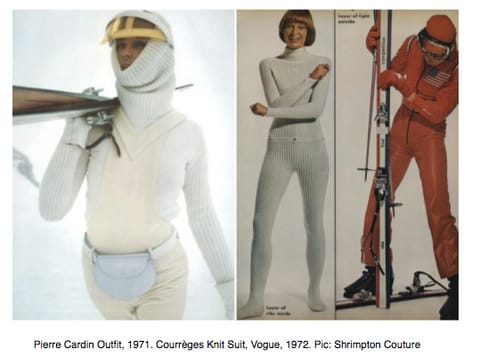SKI FASHION THROUGH THE AGES
The past 100 years have seen ski style change and evolve, constantly reflecting the wider fashions and cultural moments of the era. Alpine fashion is a history of people. The journey is fascinating, constantly blending the line between practicality and style. Since the turn of the century, each decade has been defined by a handful of legendary fashion moments. Here at Powderhound, we decided to break down each decade and explore some of the more iconic looks worn on the mountains.
1900s
Prior to the 20th-century skiing was a very male-dominated sport and subsequently, skiwear for women was less than practical. It was usual for women to wear heavy woollen skirts down to their ankles. This look was often completed by a thick fur scarf and extravagant hat. Both men and women’s skiwear was made entirely from wool, as this was the most effective way to stay warm in the 1900s.
1920s
By the 1920s women’s skiwear had adapted and evolved beyond the skirt. The first Winter Olympics in 1924 popularised specialised skiwear, and garments were designed with functionality in mind. Women could now don trousers, although off the slopes it would still be outrageous to do so. During the 20s, any respectable man would rarely be seen without the classic flat cap, a look which reached the mountains.

1930s
During the 1930s manufacturers were in the full swing of making clothes that were comfortable and practical. Women sported Norweigian trousers, pants that were baggier at the top and then cinched tightly at the ankles. These were often paired with a tailored jacket, inspired by the uniform worn by pilots. The invention of the first goose down jacket in 1936 marked the end of skiwear made out of lambswool.
1940s
By the 1940s, developments in ski lift technology called for a more streamlined look. Now that you could ski downhill at greater heights, it was essential that clothing became more aerodynamic. Women’s trousers were now slim-fitting right the way down and tops were airy, designed for mobility. The colour palette of this era consisted of earthy tones - mustard yellow, muddy brown, with the odd pop of primary red often in the form of a jacket trim. Men tucked their ski pants into a pair of argyle print socks, and it was not uncommon to spot a beret being worn.

1950s
The 1950s brought the invention of Spandex and subsequently, ski wear became more stretchy and tight-fitting. The plaid flannel parka was a strong look during this decade, as was the beanie. In 1952, inspired entrepreneurs René Ramillon and Andrè Vincent created the first Moncler Jacket, the name an abbreviation of Monestier-de-Clermont, a mountain village near Grenoble. This jacket sparks a relationship between high fashion and skiwear for years to come.

1960s
The 1960s was a glamorous time for fashion in general, and this mood reached the slopes. Manufacturers used the latest fabric technology of the time to create sleek and slender pieces. The days of bulky skiwear were over and the snood was making its first appearance. Mod ski goggles were all the rage, inspired by the space-age fashion of the time.

1970s
The 1970s saw jumpsuits paired with turtlenecks complete with matching fluorescent accessories. Colours were big, bright and often psychedelic. Skiwear was now exclusively being made from synthetic materials, practical enough to wear as everyday clothes. Streetwear and skiwear were having a cross over, and people were loving it. Also, enter the Moonboot.

1980s
The 1980s was arguably the most iconic era for Ski fashion. Men and women both wore fluorescent neon snowsuits in bold colours. The invention of Gore-Tex meant that skiwear was lightweight, breathable and waterproof - super practical. Hairstyles achieved shocking heights due to excessive backcombing - slightly less practical.
1990s
Snowsuits were a continual theme throughout the 1990s, although the colour scheme was made up of more candy and pastel tones. Women would often sport a colour coordinated headband, and skiwear was lined with fleece to keep the wearer warm. The iconic 90s crop top made its way on to the slopes, often paired with high waisted leggings.
2000s
Throughout the Noughties, both men and women’s skiwear moved towards a baggier fit. Bulky, less tight-fitting clothes became known to be associated with the ‘snowboarder’ look. Many sported quilted parkas with faux fur hoods. The bright and bold colours and patterns of the 80s seemed to fade at the turn of the millennium, although block colours were still in.
2010s
Over the past decade, the main trend in skiwear has been specialised technical gear designed for high-performance skiing. It is common for luxury fashion houses to feature skiwear on the runway. The Moncler coat has remained a symbol of high fashion since the 50s and is still worn by the rich and glamorous today.

Ski Fashion Today
The year is 2020 and we are at the beginning of a new decade. What do you think the future of ski fashion is? The evolution of ski fashion over the past century demonstrates how advancements in fabric technology play a big part in moulding the style for that decade. Here at Powderhound, we make all our clothes from organic cotton, a sustainable fabric that is kinder on the planet. In recent years, we have seen an increase in alpine eco-initiatives and an emphasis on preserving the mountains for future generations to enjoy. Perhaps the next step for ski fashion is to see skiwear steering towards more sustainable, ethical materials.

